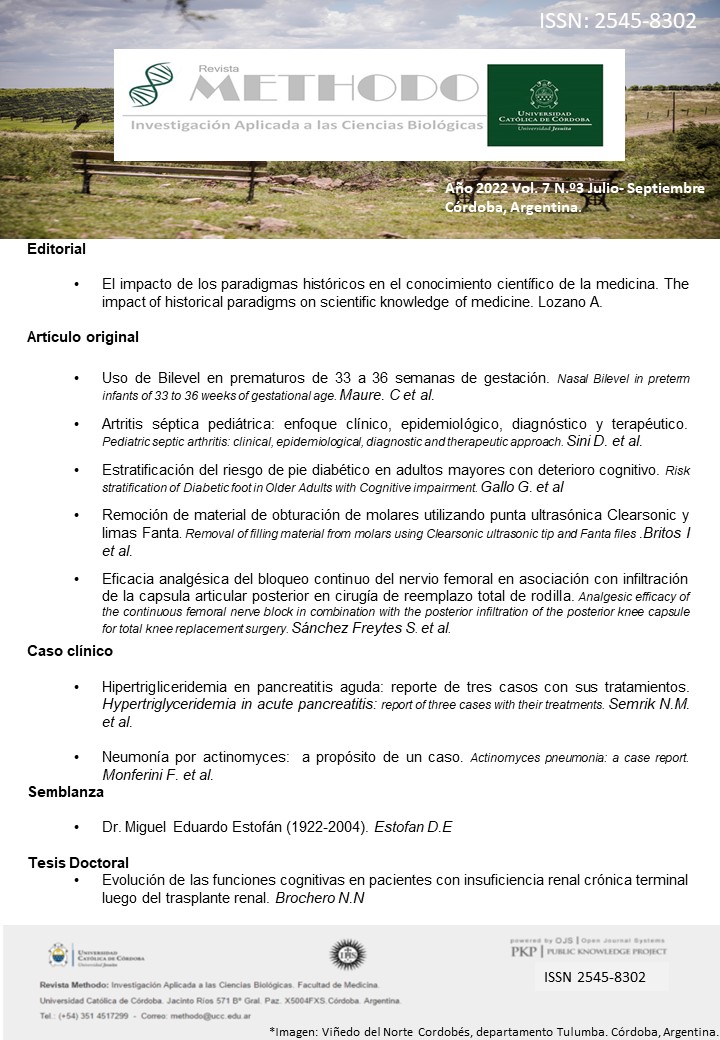Artritis séptica pediátrica: enfoque clínico, epidemiológico, diagnóstico y terapéutico
DOI:
https://doi.org/10.22529/me.2022.7(3)03Palabras clave:
artritis infecciosa, pediatría, articulaciones, terapéuticaResumen
INTRODUCCIÓN: La artritis séptica pediátrica (ASP) es una emergencia ortopédica que consiste es una infección bacteriana del espacio articular. El diagnóstico tardío puede llevar a complicaciones importantes hasta en un 12 % de los casos. El diagnóstico y el tratamiento precoz son imprescindibles para minimizar la discapacidad permanente. Las articulaciones principalmente comprometidas son la rodilla en el 35 % de los casos, la cadera 35 %, y el tobillo en el 10 %; y su localización anatómica no depende del agente etiológico. El diagnóstico se basa en la anamnesis, el examen físico, los datos de laboratorio y los estudios por imágenes. Las imágenes son de especial importancia en el diagnóstico de ASP de cadera y hombro dado la dificultad del diagnóstico clínico. La identificación del patógeno responsable es el gold standard del diagnóstico de la ASP, aunque solo se logra en un 20-80 % de los casos. El tratamiento debe realizarse sin dilataciones y consiste en drenaje quirúrgico, antibioticoterapia y eventual inmovilización. OBJETIVO: Describir el perfil epidemiológico, clínico, ortopédico, microbiológico, la metodología diagnóstica y el tratamiento realizado en la población pediátrica con diagnóstico de ASP en la Clínica Universitaria Reina Fabiola (CURF). MATERIALYMÉTODO: Estudio retrospectivo, observacional y descriptivo. Se analizaron los datos registrados en las historias clínicas desde marzo del 2012 hasta julio del 2018 en la CURF de pacientes pediátricos de 0 a 16 años de edad con diagnóstico de ASP. Se recogieron datos clínicos y demográficos de estos pacientes, los resultados de la analítica de sangre, hemocultivo y artrocentesis. Se utilizaron los criterios de Kocher-Levine-Caird y de Jung para el diagnóstico de ASP. Se analizaron los protocolos quirúrgicos empleados, teniendo en cuenta y describiendo la técnica quirúrgica practicada. Se recogieron datos referentes al tratamiento médico realizado como el antibiótico administrado, vía de administración y la duración del mismo. Seguimiento, evolución clínica y presencia de complicaciones. RESULTADOS: Se incluyeron un total de 12 pacientes con el diagnóstico de ASP, que requirieron manejo hospitalario. Once (91,7 %) de los casos corresponden a pacientes ambulatorios y solo se presentó un (8,3 %) caso de infección intrahospitalaria. Del total de casos, 10 (83,3 %) fueron procedentes de la ciudad de Córdoba capital y tan solo dos (16,7 %) del interior de la provincia de Córdoba. Se presentaron cinco (41,7 %) niños mayores de dos años con un promedio±DE de edad en años de 8,8±5,8 y 7 (58,3 %) menores de dos años con un promedio±DE de edad en meses de 13±6,8. Del total de pacientes incluidos la distribución por género fue de 8 (66,7 %) de sexo masculino y 4 (33,3 %) femenino. La totalidad de la muestra, 12 (100 %) casos, presentaron compromiso mono articular en miembros inferiores. Los parámetros clínicos y analíticos de los criterios de Kocher, Levine y Caird arrojaron los siguientes resultados: seis (50 %) presentaron más de cuatro criterios, pero en ningún caso (0 %) se presentaron cinco criterios. Según los criterios de Jung, encontramos que doce (100 %) casos presentaron más de cuatro criterios para ASP; pero el número se reduce a 6 (50 %), cuando presentan más de cinco factores. A la totalidad de los pacientes (doce, 100 %) se le practicó un tratamiento antibiótico endovenoso. En el momento del diagnóstico, la totalidad (100 %) de los pacientes fue sometida a una intervención quirúrgica. La evolución ha sido favorable en los 12 (100 %) casos, con curación y movilidad articular completa sin secuelas. CONCLUSIONES: Podemos concluir que la mayoría de los pacientes con ASP presenta un compromiso mono articular en miembros inferiores. Predomina en menores de dos años y en el sexo masculino. El principal factor de riesgo asociado fueron las lesiones en piel. El SA es el microorganismo responsable de la mayoría de las ASP. La ecografía es el principal método complementario de diagnóstico utilizado. En cuanto a los criterios de Jung, la totalidad de la serie presento cuatro o más criterios. En nuestro grupo de estudio una disminución del mayor del 30% de la PCR junto con la ausencia de fiebre son herramientas valiosas en el seguimiento y al momento de evaluar si hubo una repuesta satisfactoria al tratamiento. No se observaron complicaciones asociadas al tratamiento antibiótico y quirúrgico realizado. El requerimiento de estancia hospitalaria fue considerablemente corto.Descargas
Referencias
Hernandez T, Zarzoso Fernandez S, et al. Osteomielitis y Artritis Séptica. Protocolos diagnosticos-terapeuticos de la AEP: Infectología pediátrica. 201; 20:205-220.
Christiansen Glazowski T, J. Frederiksen B, Epidemiologic, bacteriologic, and long-term follow-up data of children with acute hematogenous osteomyelitis and septic arthritis: a ten-year review. J Pediatr Orthop B 1999; 8:302-5. https://doi.org/10.1097/01202412-199910000-00014
Nunn TR, Cheung WY, Rollinson PD. A prospective study of pyogenic sepsis of the hip in childhood. J Bone Joint Surg 2007; 89-B: 100-106. https://doi.org/10.1302/0301-620X.89B1.17940
Paakkonen M, Peltola H. Management of a child with suspected acute septic arthritis. Arch Dis Child. 2012 Mar;97(3):287-92. https://doi.org/10.1136/archdischild-2011-300462
Welkon CJ, Long SS, Fisher MC, Alburger PD. Pyogenic arthritis in infants and children: a review of 95 cases. Pediatr Infect Dis 1986; 5:669676. https://doi.org/10.1097/00006454-198611000-00014
Nelson JD, Koontz WC. Septic arthritis in infants and children: a review of 117 cases. Pediatrics 1966:38:966-971. https://doi.org/10.1542/peds.38.6.966
Al Saadi MM, Al Zamil FA, Bokhary NA et al. Acute septic arthritis in children. Pediatr Int 2009; 51: 377-380. https://doi.org/10.1111/j.1442-200X.2008.02791.x
Rutz E, Brunner R. Septic arthritis of hip - current concepts. Hip Int. 2009 Jan-Mar; 19 Suppl 6: S9-12 https://doi.org/10.1177/112070000901906s03
Gutierrez K. Bone and joint infections in children. Pediatr Clin North Am. 2005 Jun;52(3):779-94. https://doi.org/10.1016/j.pcl.2005.02.005
Kocher MS, Zurakowski D, Kasser J. Differentiating between septic arthritis and transient synovitis of the hip in children: an evidence-based clinical prediction algorithm J Bone Joint Surg Am 1999;81:1662-70. https://doi.org/10.2106/00004623-199912000-00002
Dodwell ER. Osteomyelitis and septic arthritis in children: Current concepts. Curr Opin Pediatr. 2013 Feb;25(1):5863. https://doi.org/10.1097/MOP.0b013e32835c2b42
Paakkonen M, Kallio MJ, Kallio PE, Peltola H. Sensitivity of erythrocyte sedimentation rate and C-reactive protein in childhood bone and joint infections. Clin Orthop Relat Res. 2010; 468:861-6.
https://doi.org/10.1007/s11999-009-0936-1
Levine MJ, McGuire KJ, McGowan KL, Flynn JM. Assessment of the test characteristics of C-reactive protein for septic arthritis in children. J Pediatr Orthop. 2003; 23:373-7.
https://doi.org/10.1097/01241398-200305000-00018
Caird MS, Flynn JM, Leung YL, Millman JE, D'Italia JG, Dormans JP. Factors distinguishing septic arthritis from transient synovitis of the hip in children. A prospective study. J Bone Joint Surg Am. 2006; 88:1251-7. https://doi.org/10.2106/JBJS.E.00216
Chang WS, Chiu NC, Chi H, Li WC, Huang FY. Comparison of the characteristics of culture-negative versus culturepositive septic arthritis in children. J Microbiol Immunol Infect. 2005; 38:189-93.
Castillo M, Almonte R, Ramírez C, Cabrera B, Hernández R. Características clínicas de las artritis sépticas, ArchDomPed. 1992; 28: 1218.
Kocher MS, Mandinga R, Murphy JM, Goldmann D, Harper M, Sundel R, Ecklund K, Kasser J. A clinical practice guideline for treatment of septic arthritis in children: efficacy in improving process of care and effect on outcome of septic arthritis of the hip. J Bone Joint Surg Am 2003; 85:994-9. https://doi.org/10.2106/00004623-200306000-00002
Givon U, Ganel A. Treatment of early septic arthritis of the hip in children: Comparison of results of open arthrotomy versus arthroscopic drainage. J Child Orthop. 2008; 2:499. https://doi.org/10.1007/s11832-008-0138-5
El-Sayed AM. Treatment of early septic arthritis of the hip in children: comparison of results of open arthrotomy versus arthroscopic drainage. J Child Orthop. 2008 Jun;2(3):229-37. https://doi.org/10.1007/s11832-008-0094-0
Jalil, Andres M, Bulacio Podio E, Theaux, Ricardo R. Protocolo Médico de Dolor Agudo de Cadera en pacientes pediátricos. Clínica Universitaria Reina Fabiola. Última revisión Agosto 2017.
Chiappini E, Mastrolia MV, Galli L, De Martino M, et al. Septic arthritis in children in resource limited and nonresource limited countries: an update on diagnosis and treatment. Expert Rev Anti Infect Ther. 2016 Nov;14(11):1087-1096. Epub 2016 Sep 21. https://doi.org/10.1080/14787210.2016.1235973
Moro-Lago I, Talavera G, Moraleda L, González-Morán G. Presentación clínica y tratamiento de las artritis sépticas en niños. Rev Esp Cir Ortop Traumatol. 2017 May - Jun;61(3):170175. https://doi.org/10.1016/j.recot.2017.02.002
Caksen H, Oztürk MK, Uzüm K, Yüksel S, et al. Septic arthritis in childhood. Pediatr Oct;42(5):534-40. Int. 2000 https://doi.org/10.1046/j.1442-200x.2000.01267.x
Yagupsky P, Bar-Ziv Y, Howard CB, Dagan R. Epidemiology, etiology, and clinical features of septic arthritis in children younger than 24 months. Arch Pediatr Adolesc May;149(5):537-40. Med. 1995 https://doi.org/10.1001/archpedi.1995.02170180067010
Agarwal A, Aggarwal AN. Bone and Joint Infections in Children: Septic Arthritis. Indian J Pediatr. 2016 Aug;83(8):825-33. doi: 10.1007/s12098-015-1816-1. 2015 Jul 21. Epub https://doi.org/10.1007/s12098-015-1816-1
Speiser JC, Moore TL, Osborn TG, Weiss TD, Zuckner J. Changing trends in pediatric septic arthritis. Semin Arthritis Rheum. 1985 Nov;15(2):1328. https://doi.org/10.1016/0049-0172(85)90031-9
Peltola H, Pääkkönen M, Kallio P, Kallio MJ; Osteomyelitis-Septic Arthritis Study Group. Prospective, randomized trial of 10 days versus 30 days of antimicrobial treatment, including a short-term course of parenteral therapy, for childhood septic arthritis. Clin Infect Dis. 2009 May 1;48(9):1201-10. https://doi.org/10.1086/597582
Ramos Amador JT, López Laso E, Romero Blanco I, Alba Romero C, et al. Septic osteoarthritis in children. An Esp Pediatr. 1998 Nov;49(5):481-6.
Barton LL, Dunkle LM, Habib FH. Septic arthritis in childhood. A 13-year review. Am J Dis Child. 1987 Aug;141(8):898-900. https://doi.org/10.1001/archpedi.1987.04460080084034
Mooney JF, Murphy RF. Septic arthritis of the pediatric hip: update on diagnosis and treatment. Curr Opin Pediatr. 2019 Feb;31(1):79-85. https://doi.org/10.1097/MOP.0000000000000703
Volberg FM, Sumner TE, Abramson JS, Winchester PH. Unreliability of radiographic diagnosis of septic hip in children. Pediatrics. 1984 Jul;74(1):118-20. https://doi.org/10.1542/peds.74.1.118
Plumb J, Mallin M, Bolte RG. The role of ultrasound in the emergency department evaluation of the acutely painful pediatric hip. Pediatr Emerg Care. 2015 Jan;31(1):54-8; quiz 59-61. https://doi.org/10.1097/PEC.0000000000000332
Dörr U, Zieger M, Hauke H. Ultrasonography of the painful hip. Prospective studies in 204 patients. Pediatr Radiol. 1988;19(1):36-40. https://doi.org/10.1007/BF02388408
McGoldrick F, Bourke T, Blake N, Fogarty E, et al. Accuracy of sonography in transient synovitis. J Pediatr Orthop. 1990 Aug;10(4):501-3. https://doi.org/10.1097/01241398-199007000-00015
JulMerino R, de Inocencio J, GarcíaConsuegra J. Differentiation between transient synovitis and septic arthritis of the hip with clinical and ultrasound criteria. An Pediatr (Barc). 2010 Oct;73(4):189-93.
Yang WJ, Im SA, Lim GY, Chun HJ, et al. MR imaging of transient synovitis: differentiation from septic arthritis. Pediatr Radiol. 2006 Nov;36(11):11548. Epub 2006 Sep 20. https://doi.org/10.1007/s00247-006-0289-9
Gottschalk HP, Moor MA, Muhamad AR, Wenger DR, et al. Improving diagnostic efficiency: analysis of pelvic MRI versus emergency hip aspiration for suspected hip sepsis. J Pediatr Orthop. 2014 Apr-May;34(3):300-6. https://doi.org/10.1097/BPO.0000000000000097
Song KS, Lee SW, Bae KC. Key role of magnetic resonance imaging in the diagnosis of infections around the hip and pelvic girdle mimicking septic arthritis of the hip in children. J Pediatr Orthop B. 2016 May;25(3):234-40 https://doi.org/10.1097/BPB.0000000000000268
Rosenfeld S, Bernstein DT, Daram S, Dawson J, et al. Predicting the Presence of Adjacent Infections in Septic Arthritis in Children. J Pediatr Orthop. 2016 Jan;36(1):70-4. https://doi.org/10.1097/BPO.0000000000000389
Tuson CE, Hoffman EB, Mann MD. Isotope bone scanning for acute osteomyelitis and septic arthritis in children. J Bone Joint Surg Br. 1994 Mar;76(2):306-10. https://doi.org/10.1302/0301-620X.76B2.8113299
Unkila-Kallio L, Kallio MJ, Peltola H. The usefulness of C-reactive protein levels in the identification of concurrent septic arthritis in children who have acute hematogenous osteomyelitis. A comparison with the usefulness of the erythrocyte sedimentation rate and the white blood-cell count. J Bone Joint Surg Am. 1994 Jun;76(6):848-53. https://doi.org/10.2106/00004623-199406000-00008
Taylor GR, Clarke NMP. Managament of irritable hip: a review of hospital admission policy. Arch Dis Child. 1994 Jul;71(1):59-63. https://doi.org/10.1136/adc.71.1.59
Del Beccaro MA, Champoux AN, Bockers T, Mendelman PM. Septic arthritis versus transient synovitis of the hip: the value of screening laboratory tests. Ann Emerg Med. 1992 Dec;21(12):1418-22. https://doi.org/10.1016/S0196-0644(05)80052-6
Kunnamo I, Kallio P, Pelkonen P, Hovi T. Clinical signs and laboratory tests in the differential diagnosis of arthritis in children. Am J Dis Child. 1987 Jan;141(1):34-40. https://doi.org/10.1001/archpedi.1987.04460010034018
Peltola H, Vahvanen V, Aalto K. Fever, C-reactive erythrocyte protein, and sedimentation rate in monitoring recovery from septic arthritis: a preliminary study. J Pediatr Orthop. 1984 Mar;4(2):170-4. https://doi.org/10.1097/01241398-198403000-00004
Basmaci R, Ilharreborde B, Bonacorsi S, Kahil M, et al. Septic arthritis in children with normal initial C-reactive protein: clinical and biological features. Arch Pediatr. 2014 Nov;21(11):1195-9. https://doi.org/10.1016/j.arcped.2014.08.032
Pendleton A, Kocher MS. Methicillinresistant staphylococcus aureus bone and joint infections in children. J Am Acad Orthop Surg. 2015 Jan;23(1):2937. https://doi.org/10.5435/JAAOS-23-01-29
Pittard WB 3rd, Thullen JD, Fanaroff AA. Neonatal septic arthritis. J Pediatr. 1976 Apr;88(4 Pt 1):621-4. https://doi.org/10.1016/S0022-3476(76)80022-4
Kang SN, Sanghera T, Mangwani J, Paterson JM, Ramachandran M. The management of septic arthritis in children: systematic review of the English language literature. J Bone Joint Surg Br. 2009 Sep;91(9):1127-33. https://doi.org/10.1302/0301-620X.91B9.22530
Rosa, JRP, Kojima, CM, Fernandes, LFL, Hehn, BJ et al. Fluxograma diferencial entre a artrite séptica e sinovite transitória do quadril em crianças. 2011. Acta Ortopédica Brasileira, 19(4), 202-205. https://doi.org/10.1590/S1413-78522011000400006
Maharajan K, Patro DK, Menon J, Hariharan AP, et al. Serum Procalcitonin is a sensitive and specific marker in the diagnosis of septic arthritis and acute osteomyelitis. J Orthop Surg Res. 2013 Jul 4; 8:19. https://doi.org/10.1186/1749-799X-8-19
Sukswai P, Kovitvanitcha D, Thumkunanon V, Chotpitayasunondh T, et al. Acute hematogenous osteomyelitis and septic arthritis in children: clinical characteristics and outcomes study. J Med Assoc Thai. 2011 Aug;94 Suppl 3: S209-16.
Nelson JD. Bone and joint infections. Pediatr Infect Dis. 1983 May-Jun;2(3 Suppl): S45-50.
Sultan J, Hughes PJ. Septic arthritis or transient synovitis of the hip in children: the value of clinical prediction algorithms. J Bone Joint Surg Br. 2010 Sep;92(9):1289-93. https://doi.org/10.1302/0301-620X.92B9.24286
Jung ST, Rowe SM, Moon ES, Song EK, et al. Significance of laboratory and radiologic findings for differentiating between septic arthritis and transient synovitis of the hip. J Pediatr Orthop. 2003 May-Jun;23(3):368-72. https://doi.org/10.1097/01241398-200305000-00017
Tanwar YS, Jaiswal A, Singh S, Arya RK, et al. Acute pediatric septic arthritis: a systematic review of literature and current controversies. Pol Orthop Traumatol. 2014 Mar 31; 79:239.
Pääkkönen M, Kallio MJ, Peltola H, Kallio PE. Pediatric septic hip with or without arthrotomy: retrospective analysis of 62 consecutive nonneonatal culture-positive cases. J Pediatr Orthop B. 2010 May;19(3):264-9. https://doi.org/10.1097/BPB.0b013e32833822be
Rutz E, Spoerri M. Septic arthritis of the paediatric hip - A review of current diagnostic approaches and therapeutic concepts. Acta Orthop Belg. 2013 Apr;79(2):123-34.
Sanchez AA, Hennrikus WL. Arthroscopically assisted treatment of acute septic knees in infants using the Micro-Joint Arthroscope. Arthroscopy. 1997 Jun;13(3):350-4. https://doi.org/10.1016/S0749-8063(97)90033-5
Thompson RM, Gourineni P. Arthroscopic Treatment of Septic Arthritis in Very Young Children. J Pediatr Orthop. 2017 Jan;37(1): e53e57. https://doi.org/10.1097/BPO.0000000000000659
Ballock RT, Newton PO, Evans SJ, Estabrook M, et al. A comparison of early versus late conversion from intravenous to oral therapy in the treatment of septic arthritis. J Pediatr Orthop. 2009 Sep;29(6):636-42. https://doi.org/10.1097/BPO.0b013e3181b2b860
Dagan R. Management of acute hematogenous osteomyelitis and septic arthritis in the pediatric patient. Pediatr Infect Dis J. 1993 Jan;12(1):88-92. https://doi.org/10.1097/00006454-199301000-00018
Arkader A, Brusalis C, Warner WC Jr, Conway JH, Noonan K. Update in Pediatric Musculoskeletal Infections: When It Is, When It Isn't, and What to Do. J Am Acad Orthop Surg. 2016 Sep;24(9): e112-21. https://doi.org/10.5435/JAAOS-D-15-00714
Nicole Le Saux. Septic arthritis of the pediatric hip: update on diagnosis and treatment. Paediatr Child Health. 2018 Aug;23(5):336-343.
https://doi.org/10.1093/pch/pxy049
Chou AC, Mahadev A. The Use of Creactive Protein as a Guide for Transitioning to Oral Antibiotics in Pediatric Osteoarticular Infections. J Pediatr Orthop. 2016 Mar;36(2):173-7. https://doi.org/10.1097/BPO.0000000000000427
Jagodzinski NA, Kanwar R, Graham K, Bache CE. Prospective evaluation of a shortened regimen of treatment for acute osteomyelitis and septic arthritis in children. J Pediatr Orthop. 2009 JulAug;29(5):518-25. https://doi.org/10.1097/BPO.0b013e3181ab472d
Arnold JC, Cannavino CR, Ross MK, Westley B, at al. Acute bacterial osteoarticular infections: eight-year analysis of C-reactive protein for oral step-down therapy. Pediatrics. 2012 Oct;130(4): e821-8. https://doi.org/10.1542/peds.2012-0220
Pääkkönen M, Kallio MJ, Kallio PE, Peltola H. Shortened hospital stay for childhood bone and joint infections: analysis of 265 prospectively collected culture-positive cases in 1983-2005. Scand J Infect Dis. 2012 Sep;44(9):6838. https://doi.org/10.3109/00365548.2012.673729
Wall C, Donnan L. Septic arthritis in children. Aust Fam Physician. 2015 Apr;44(4):213-5.
Lavy CB, Thyoka M. For how long should antibiotics be given in acute paediatric septic arthritis? A prospective audit of 96 cases. Trop Doct. 2007 Oct;37(4):195-7. https://doi.org/10.1258/004947507782332775
Peters W, Irving J, Letts M. Long-term effects of neonatal bone and joint infection on adjacent growth plates. J Pediatr Orthop. 1992 Nov-Dec;12(6):806-10. https://doi.org/10.1097/01241398-199211000-00020
McCarthy JJ, Dormans JP, Kozin SH, Pizzutillo PD. Musculoskeletal infections in children: basic treatment principles and recent advancements. Instr Course Lect. 2005; 54:515-28.












